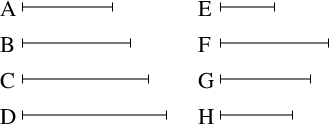Proof: By Euclid
(related to Proposition: Prop. 9.12: Elements of Geometric Progression from One Divisible by Prime)

- For let $D$ be measured by some prime number $E$.
- I say that $E$ measures $A$.
- For (suppose it does) not.
- $E$ is prime, and every prime number is prime to every number which it does not measure [Prop. 7.29].
- Thus, $E$ and $A$ are prime to one another.
- And since $E$ measures $D$, let it measure it according to $F$.
- Thus, $E$ has made $D$ (by) multiplying $F$.
- Again, since $A$ measures $D$ according to the units in $C$ [Prop. 9.11 corr.] , $A$ has thus made $D$ (by) multiplying $C$.
- But, in fact, $E$ has also made $D$ (by) multiplying $F$.
- Thus, the (number created) from (multiplying) $A$, $C$ is equal to the (number created) from (multiplying) $E$, $F$.
- Thus, as $A$ is to $E$, (so) $F$ (is) to $C$ [Prop. 7.19].
- And $A$ and $E$ (are) prime (to one another), and (numbers) prime (to one another are) also the least (of those numbers having the same ratio as them) [Prop. 7.21], and the least (numbers) measure those (numbers) having the same ratio as them an equal number of times, the leading (measuring) the leading, and the following the following [Prop. 7.20].
- Thus, $E$ measures $C$.
- Let it measure it according to $G$.
- Thus, $E$ has made $C$ (by) multiplying $G$.
- But, in fact, via the (proposition) before this, $A$ has also made $C$ (by) multiplying $B$ [Prop. 9.11 corr.] .
- Thus, the (number created) from (multiplying) $A$, $B$ is equal to the (number created) from (multiplying) $E$, $G$.
- Thus, as $A$ is to $E$, (so) $G$ (is) to $B$ [Prop. 7.19].
- And $A$ and $E$ (are) prime (to one another), and (numbers) prime (to one another are) also the least (of those numbers having the same ratio as them) [Prop. 7.21], and the least (numbers) measure those (numbers) having the same ratio as them an equal number of times, the leading (measuring) the leading, and the following the following [Prop. 7.20].
- Thus, $E$ measures $B$.
- Let it measure it according to $H$.
- Thus, $E$ has made $B$ (by) multiplying $H$.
- But, in fact, $A$ has also made $B$ (by) multiplying itself [Prop. 9.8].
- Thus, the (number created) from (multiplying) $E$, $H$ is equal to the (square) on $A$.
- Thus, as $E$ is to $A$, (so) $A$ (is) to $H$ [Prop. 7.19].
- And $A$ and $E$ are prime (to one another), and (numbers) prime (to one another are) also the least (of those numbers having the same ratio as them) [Prop. 7.21], and the least (numbers) measure those (numbers) having the same ratio as them an equal number of times, the leading (measuring) the leading, and the following the following [Prop. 7.20].
- Thus, $E$ measures $A$, as the leading (measuring the) leading.
- But, in fact, ($E$) also does not measure ($A$).
- The very thing (is) impossible.
- Thus, $E$ and $A$ are not prime to one another.
- Thus, (they are) composite (to one another).
- And (numbers) composite (to one another) are (both) measured by some [prime] number [Def. 7.14] .
- And since $E$ is assumed (to be) prime, and a prime (number) is not measured by another number (other) than itself [Def. 7.11] , $E$ thus measures (both) $A$ and $E$.
- Hence, $E$ measures $A$.
- And it also measures $D$.
- Thus, $E$ measures (both) $A$ and $D$.
- So, similarly, we can show that however many prime numbers $D$ is measured by, $A$ will also be measured by the same (prime numbers).
- (Which is) the very thing it was required to show.
∎
Thank you to the contributors under CC BY-SA 4.0! 

- Github:
-

- non-Github:
- @Fitzpatrick
References
Adapted from (subject to copyright, with kind permission)
- Fitzpatrick, Richard: Euclid's "Elements of Geometry"
